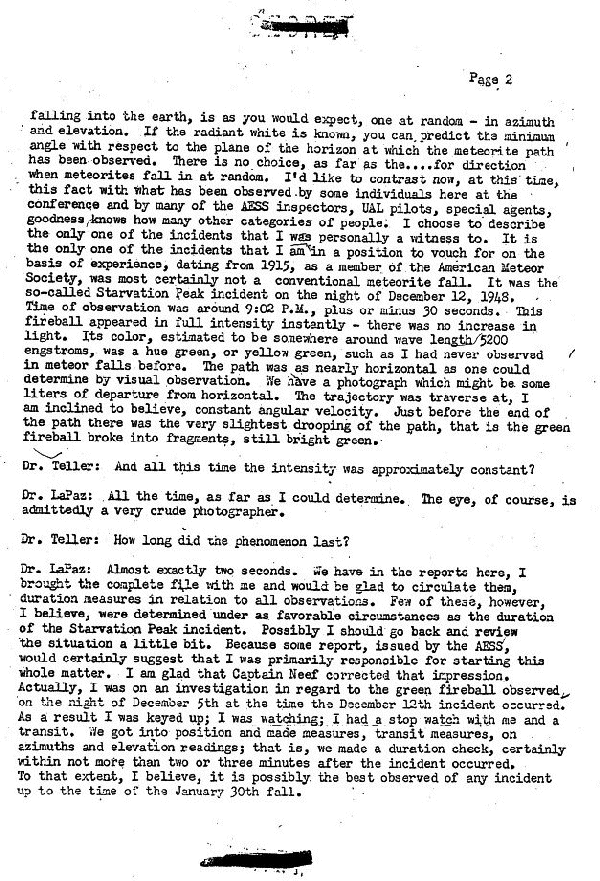This is one of the 24 pages of one of the many formerly secret official documents on this issue. These pages are the minutes of an important conference on the issue held at Los Alamos on February 16, 1949. Representatives of the Army, the FBI, the Air Force and scientists joined together. Dr. La Paz spent two years chasing the green fireballs and explains the issues. Dr. Edward Teller, one of the fathers of the atomic bomb, asks questions.
1 2 3 4 5 6 7 8 9 10 11 12 13 14 15 16 17 18 19 20 21 22 23 24

|
falling into the earth, is as you would expect, one at random - in azimuth and elevation. If the radiant white [sic, width] is known, you can predict its minimum angle with respect to the plane of horizon at which the meteorite path has been observed. There is no choice, as far as the ... for direction when meteorites fall in at random. I'd like to contrast now, at this time, this fact with what has been observed by some individuals here at the conference and by many of the AESS inspectors [security], UAL [United Airlines] pilots, special agents, goodness knows how many other categories of people. I choose to describe the only one of the incidents that I was personaly a witness to. It is the only one of the incidents that I am in a position to vouch for on the basis of experience, dating from 1915, as a member of the American Meteor Society, was most certainly not a conventional meteorite fall. It was the so-called Starvation Peak incident on the night of December 12, 1948. Time of observation was around 9:02 P.M., plus or minus 30 seconds. This fireball appeared in fill intensity instantly - there was no increase in light. Its color, estimated to be somewhat around wave length 5200 angstrom, was a hue green, or yellow green, such as I have never observed in meteor falls before. The path was as nearly horizontal as one would determine by visual observation. We have a photograph which might be some liters of departure from horizontal. The trajectory was traverse at, I am inclined to believe, constant angular velocity. Just before the end of the path there was the very slightest drooping of the path, that is the green fireball broke into fragments, still bright green.
Dr. Teller: And all this time the intensity was approximately constant?
Dr. LaPaz: All the time, as far as I could determine. The eye, of course, is admittedly a very crude photographer.
Dr. Teller: How long did the phenomenon last?
Dr. La Paz: Almost exactly two seconds. We have in the reports here, I brought the complete file with me and would be glad to circulate them, duration measures in relation to all observations. Few of these, however, I believe, were determined under as favorable circumstances as the duration of the Starvation Peak incident. Possibly I should go back and review the situation a little bit. Because some reports, issued by the AESS, would certainly suggest that I was primarily responsible for starting this whole matter. I am glad that Captain Neef corrected that impression. Actually, I was on an investigation in regard to the green fireball observed on the night of December 5th at the time the December 12th incident occurred. As a result I was eyed up, I was watching; I had a stopwatch with me and a transit. We got into position and made measures, transit measures, on azimuths and elevation readings; that is, we made a duration check, certainly within not more than two or three minutes after the incident occurred. To that extent, I believe, it is possibly the best observed of any incident up to the time of the January 30th fall.
1 2 3 4 5 6 7 8 9 10 11 12 13 14 15 16 17 18 19 20 21 22 23 24